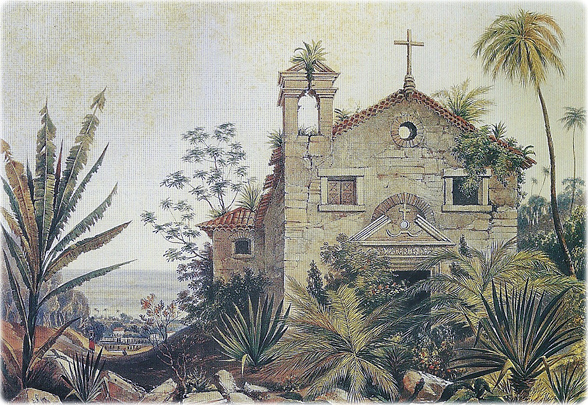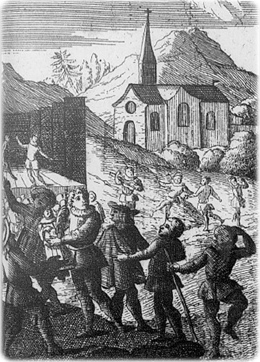
Antiga Capela de São Gonçalo
A Capela de São Gonçalo do Rio Vermelho foi provavelmente a primeira igreja dedicada ao santo, no Brasil, construída entre 1636 e 1695. Em 1724, o templo foi doado ao Mosteiro de São Bento. No final do século 18, a imagem de São Gonçalo foi transferida para a Igreja do Bonfim e a festa de São Gonçalo foi adaptada para o novo local.

Rio Vermelho
Ruínas da Capela de São Gonçalo, vista do interior, por W. G. Ouseley, em 1835. Ouseley notou que os vestígios de vários detalhes ornamentais e o mármore bem cortado, atestavam o cuidado e o custo com que o templo fora construído.
A devoção a São Gonçalo do Amarante era uma tradição na Bahia antiga, herdada dos portugueses. O padre Antônio Vieira escreveu o Sermão de São Gonçalo, de caráter pastoral. Se Vieira proferiu seu Sermão em alguma igreja, poderia ter sido nessa Capela, embora existisse na época a igreja de São Gonçalo do Retiro e a de São Francisco do Conde, também dedicada a São Gonçalo.
A festa de São Gonçalo do Amarante, em Salvador, foi registrada em gravura de 1718 por Le Roux Durant (ao lado). A ilustração da capela, contudo, não parece corresponder à realidade, pois foge completamente à arquitetura das igrejas da época, na Cidade.
A Capela localizava-se no alto da atual rua Almirante Barroso, no bairro do Rio Vermelho. O local ainda é conhecido como o Alto de São Gonçalo.


A seguir, texto extraído do livro Views in South America from original drawings made in Brazil, the River Plate and Parana, de W. G. Ouseley, publicado em 1852. William Gore Ouseley (1797-1866), foi um diplomata inglês que esteve na Bahia, em 1835, e fez algumas ilustrações, que foram litografadas por J. Needham.
PLATE, No. VI - BAHIA - RUINED CHAPEL OF SAN GONÇALO
A few miles from Bahia, on the Atlantic coast, near Rio Vermelho, is a small ruined chapel that may easily escape the attention of a traveller, unless more addicted to exploring the recesses of a picturesque country than the inhabitants or resident foreigners, who are naturally absorbed in more profitable pursuits.
On approaching it, which was not very easy, as the paths were overgrown with the dense underwood and rich vegetation common in this country, the solitary and deserted aspect of the little chapel, and its picturesque position and interior, rendered it an object of interest.
In reply to inquiry of the people casually met on the road at Rio Vermelho (probably not very competent authorities,) it was stated to be the Chapel of St Gonçalo; among the first edifices, some said the first building, devoted to Christian worship, constructed in Brazil, or as others added, in America. As its very existence seemed unknown at Bahia, this history was accepted, especially as its correctness by no means detracted from the effect of the little ruin in an artistic point of view.
On examination, by cutting away some of the plants by which the interior is thickly overgrown, vestiges of various ornamental details in well-cut stone or marble, attested the care with which this secluded place of worship was formerly ornamented, and the cost at which it must have been constructed.
One is sometimes unaccountably interested by the discovery (as it may be termed) of relics proving former religious zeal or architectural skill, in the midst of what is now a deserted solitude. Some such interest is all that can be pleaded for offering sketches of a place so little known, and of so little importance as the ruined chapel of San Gonçalo.
Ruínas da Capela de São Gonçalo, em 1835, por William Gore Ouseley.
Festa religiosa de São Gonçalo do Amarante em Salvador, em 1718. Ilustração de Le Roux Durant em livro do francês Guy le Gentil de la Barbinais.
◄ Salvador
|
Copyright © Guia Geográfico - Bahia |

Antiga Capela de São Gonçalo